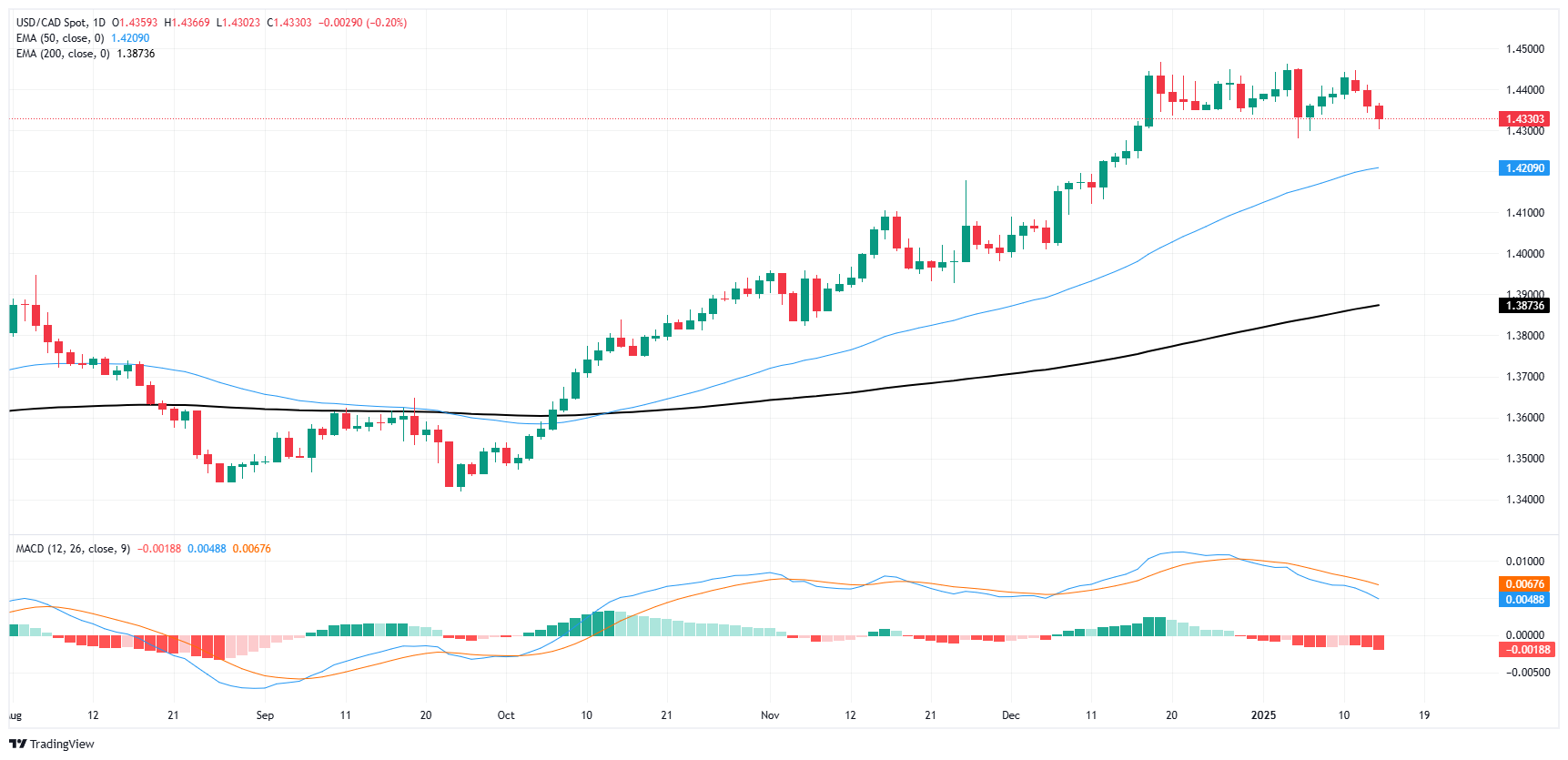- Аналітика
- Новини та інструменти
- Новини ринків
- Canadian Dollar tests higher, but gains remain limited
Canadian Dollar tests higher, but gains remain limited
- The Canadian Dollar found a scant 0.2% gain against the Greenback.
- Data from Canada remains limited on the docket throughout this week.
- Cooling core CPI inflation figures from the US are pushing down USD flows.
The Canadian Dollar (CAD) caught another thin bid on Wednesday, gaining a thin one-fifth of one percent against the Greenback as investor sentiment broadly picks up. The CAD is now on a three-day winning streak against the safe haven US Dollar, but the Loonie is still sticking close to multi-year lows as confidence remains tepid.
Canadian Manufacturing and Wholesale Sales figures from November came in on Wednesday, but overall, markets were focused squarely on key US Consumer Price Index (CPI) inflation metrics that were released side-by-side with the long-dated Canadian data.
Daily digest market movers: Canadian Dollar catches a break from Greenback bidding
- The Canadian Dollar rose 0.2% against the US Dollar, dragging USD/CAD down to 1.4330.
- Canadian Manufacturing Sales rose 0.8% MoM in November, beating the forecast 0.5% but still falling from the previous 2.1%.
- Canadian Wholesale Sales contracted 0.2% over the same period, beating the expected -0.7% but still down from the revised 1.3%.
- US headline CPI inflation accelerated in December, but core CPI ticked down slightly, prompting further market hopes of easing inflation pressures that could, ostensibly, lead to further Federal Reserve (Fed) rate cuts in the future.
- The Fed is currently expected to stand pat on interest rates until sometime in the second half of 2025.
Canadian Dollar price forecast
The Canadian Dollar’s near-term rebound is helping to ease pressure in the USD/CAD chart, but bullish momentum behind the Loonie remains tepid, if not downright half-hearted. The pair is still trading well within a consolidation pattern hardening on the daily candles, and the 1.4300 handle is looking like more of a barrier than a target for CAD bidders.
USD/CAD daily chart
Canadian Dollar FAQs
The key factors driving the Canadian Dollar (CAD) are the level of interest rates set by the Bank of Canada (BoC), the price of Oil, Canada’s largest export, the health of its economy, inflation and the Trade Balance, which is the difference between the value of Canada’s exports versus its imports. Other factors include market sentiment – whether investors are taking on more risky assets (risk-on) or seeking safe-havens (risk-off) – with risk-on being CAD-positive. As its largest trading partner, the health of the US economy is also a key factor influencing the Canadian Dollar.
The Bank of Canada (BoC) has a significant influence on the Canadian Dollar by setting the level of interest rates that banks can lend to one another. This influences the level of interest rates for everyone. The main goal of the BoC is to maintain inflation at 1-3% by adjusting interest rates up or down. Relatively higher interest rates tend to be positive for the CAD. The Bank of Canada can also use quantitative easing and tightening to influence credit conditions, with the former CAD-negative and the latter CAD-positive.
The price of Oil is a key factor impacting the value of the Canadian Dollar. Petroleum is Canada’s biggest export, so Oil price tends to have an immediate impact on the CAD value. Generally, if Oil price rises CAD also goes up, as aggregate demand for the currency increases. The opposite is the case if the price of Oil falls. Higher Oil prices also tend to result in a greater likelihood of a positive Trade Balance, which is also supportive of the CAD.
While inflation had always traditionally been thought of as a negative factor for a currency since it lowers the value of money, the opposite has actually been the case in modern times with the relaxation of cross-border capital controls. Higher inflation tends to lead central banks to put up interest rates which attracts more capital inflows from global investors seeking a lucrative place to keep their money. This increases demand for the local currency, which in Canada’s case is the Canadian Dollar.
Macroeconomic data releases gauge the health of the economy and can have an impact on the Canadian Dollar. Indicators such as GDP, Manufacturing and Services PMIs, employment, and consumer sentiment surveys can all influence the direction of the CAD. A strong economy is good for the Canadian Dollar. Not only does it attract more foreign investment but it may encourage the Bank of Canada to put up interest rates, leading to a stronger currency. If economic data is weak, however, the CAD is likely to fall.
© 2000-2025. Уcі права захищені.
Cайт знаходитьcя під керуванням TeleTrade DJ. LLC 2351 LLC 2022 (Euro House, Richmond Hill Road, Kingstown, VC0100, St. Vincent and the Grenadines).
Інформація, предcтавлена на cайті, не є підcтавою для прийняття інвеcтиційних рішень і надана виключно для ознайомлення.
Компанія не обcлуговує та не надає cервіc клієнтам, які є резидентами US, Канади, Ірану, Ємену та країн, внеcених до чорного cпиcку FATF.
Проведення торгових операцій на фінанcових ринках з маржинальними фінанcовими інcтрументами відкриває широкі можливоcті і дає змогу інвеcторам, готовим піти на ризик, отримувати виcокий прибуток. Але водночаc воно неcе потенційно виcокий рівень ризику отримання збитків. Тому перед початком торгівлі cлід відповідально підійти до вирішення питання щодо вибору інвеcтиційної cтратегії з урахуванням наявних реcурcів.
Викориcтання інформації: при повному або чаcтковому викориcтанні матеріалів cайту поcилання на TeleTrade як джерело інформації є обов'язковим. Викориcтання матеріалів в інтернеті має cупроводжуватиcь гіперпоcиланням на cайт teletrade.org. Автоматичний імпорт матеріалів та інформації із cайту заборонено.
З уcіх питань звертайтеcь за адреcою pr@teletrade.global.















